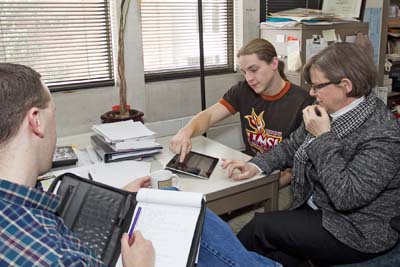
UMSL graduate students, Jacob Perkins (left) and David McGraw (far right), work with Beth Eckelkamp, associate teaching professor of anthropology, sociology and languages, on her new iPad. Eckelkamp is one of 45 faculty members who were awarded iPads to use in their classrooms. (Photo by August Jennewein)
It was one of those Aha! moments.
“People were talking at this conference about disruptive technology and I immediately thought mobile devices,” said Lawrence Frederick, chief information officer at the University of Missouri–St. Louis. “No, they were discussing apps. Applications, as in the app store.”
So, when it came time for faculty innovation grants from Information Technology Services to be awarded this year, Frederick decided to test how those apps for mobile devices could be used at UMSL. He said many applications have already been developed for higher education taking the iPad far beyond a personal entertainment device.
Working with UMSL’s Center for Teaching and Learning, ITS awarded 45 iPads earlier this month to faculty for use in their classrooms. Announcements about the grants appeared in the ITS newsletter, Iterations, and on its website in December. Full-time faculty were asked to submit a one-page application spelling out how they would use an iPad in their classrooms.
“Clearly, mobile computing is the future of us all,” Frederick said. “What better way to test it in higher education than to give the machines to those who could best use them. And we need help identifying the most useful applications for our campus.”
According to Frederick, the apps trend could mean the end of learning management systems such as Blackboard, which runs My Gateway at UMSL. The system is designed to enhance teaching and learning both inside and outside of the classroom. Course content, discussion boards, assignments, grades and much more are all handled through the one system. With the plethora of apps out there, says Frederick, those functions are being broken down into little pieces that are designed to be used on small, accessible devices and sold at affordable prices.
April Regester, assistant professor of teaching and learning teaches courses in special education, a field where assistive technology has played a large role. But the cost and complexity of some of the devices put them beyond the reach of many children and their school districts. At a cost of $500 and up, iPads and its apps are dramatically cheaper than earlier devices.
“The iPad has opened doors to many individuals with special needs in ways that they have not experienced in the past,” Regester wrote. “The growing use of iPads in schools, typically for communication, has required the need to train future educators on their use.”
Up until last week, Regester had to use video clips to illustrate how to use the iPad. She now can use an actual iPad.
Diane Saleska, associate teaching professor in the College of Nursing, knew there were very specific iPad apps for nursing – “SkyScape, Epocrates and Davis’s Drug Guide for Nurses – that provide access to complex medical information.
“Students participating in a hospital or clinical setting often need to bring 3-4 reference books with them,” said Saleska. “When patient care situations, medications and doctors orders change rapidly, the student (with an iPad)would be able to access the information on site and in the moment.”
Michael Cosmopoulos, the Hellenic Government Karakas Family Endowed Professor of Greek Studies, will use his iPad to collect and organize massive amounts of data for research at his archaeological field school at Iklaina, Greece. The dig also serves as a classroom for his students each summer.
“With the iPad, I could take entire libraries, photo albums and 3D reconstructions with me right to the site to aid in the instruction of my students,” Cosmopoulos said.
The ideas and the apps to bringing them to life seemed endless. Mary Fowler, director of ITS User Services, said this year’s Innovation Grant applicants were a more diverse group than in the past. Faculty from all colleges were represented.
“In the past, younger faculty have been more interested,” said Fowler. “But this year we had full professors applying in addition to assistant professors.”
Recipients of the iPad must attend regular meetings of the iPad Teaching Circle to share and learn innovative uses of the device and discuss which applications are appropriate to recommend to the UMSL community. Those faculty will also present their experiences in a public forum such as the Focus on Teaching and Technology Conference Nov. 1-2 or an informal faculty colloquium offered by the Center for Teaching and Learning during the 2012-2013 academic year.
CTL sponsors professional development programs for faculty, graduate students and academic leaders. Along with UMSL Online and the Faculty Resource Center, CTL is offering a Teaching with Technology Workshop series in February, March and April.
For a complete list of faculty winners, visit the Innovation Grants site.














